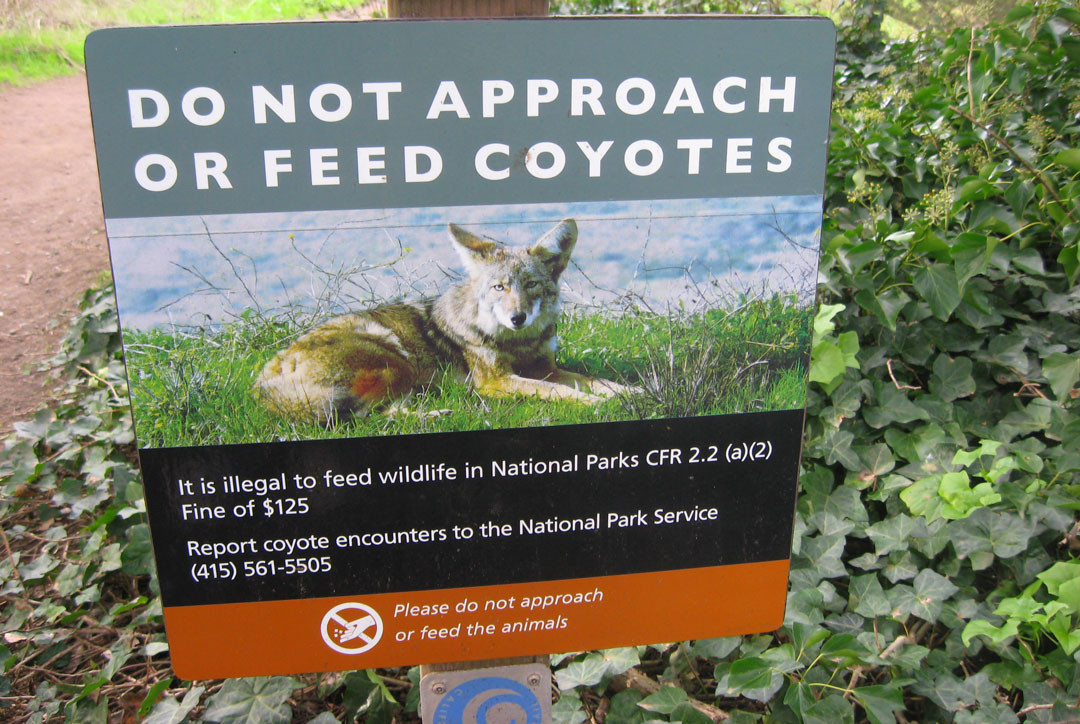Above Photo: Coyote warning sign in the San Francisco Bay Area by Javacolleen (CC BY NC ND)
By Sally Stephens
Fear is a powerful emotion. It can make reasonable people take unreasonable positions. This past summer, fear of coyotes led some in The City named after Saint Francis to call for their eradication. As a longtime dog and animal advocate in The City, I didn’t expect that from San Franciscans.
There is no doubt in my mind the fear is real. One small dog was seriously injured, and another killed by coyotes in the off-leash dog play area next to Stern Grove. Both incidents were heartbreakers, but it wasn’t just dog owners. Neighbors worried about protecting children.
The reality, however, is that coyotes pose little threat to humans, and the threats to pets can be significantly reduced if we make a few relatively small changes to our behavior: removing food and garbage left outside, taking extra precaution when walking a small dog and keeping cats inside at night.
The City has done a poor job of telling people about these precautions. And in the absence of reliable information, fear has grown.
“We need to empower people, to give them information and tools to coexist with coyotes,” Gina Farr told me. She works with Project Coyote, a nonprofit that strives to replace fear of coyotes with understanding.
“Coyotes are amazingly adaptable animals,” Farr said, “and astute urbanites.” For example, coyotes in San Francisco have been observed waiting for the streetlight to change before crossing 19th Avenue.
In a family group that can include four or more coyotes, depending on available food, only the alpha pair mate. They produce one litter — if at all — of three to seven pups once a year, although half of the pups won’t survive. When the pups are grown, they move away, roaming until they find a place that doesn’t already have coyotes. In essence, coyote populations self-regulate in a small urban geography like San Francisco.
All the other females in a group are “behaviorally sterile.” They don’t go into heat or get pregnant. However, if one or both members of the alpha pair are killed, these other females may go into heat and produce pups. Turns out the best way to keep coyote numbers down is to encourage stable family groups, not to kill them.
“It’s a fantasy that we can eradicate coyotes in cities,” Farr said. “If you kill the coyotes in Stern Grove, for example, another coyote that has been looking for a place to live will move in and take their place, and studies show that it can happen in a matter of weeks.”
The idea that coyotes, humans and pets should live together gained ground in San Francisco in 2007 after a mated pair of coyotes were shot and killed by California Fish and Game officers in Golden Gate Park after they had charged two dogs; the coyotes were likely defending pups. Indeed, nine days later, a car killed a coyote pup in the same area. San Franciscans loudly and forcefully demanded no more coyotes be killed, and The City unofficially adopted the policy of coexistence.
“Coyotes actually are good neighbors,” Farr said. “They generally keep to the edges, try to stay away from humans, to keep out of trouble. And they help keep rodent populations under control.”
The state will not allow coyotes to be moved from a city to a rural area so that is not an option. Ridding The City of coyotes isn’t either. “It would require a long, brutal campaign of killing coyotes not only in The City, but in
all the counties around it,” Farr warned.
Coyotes have been in San Francisco for 15 years. The fact that there have been few incidents in all those years shows coexistence is largely working. Wholesale killing just doesn’t feel very San Franciscan to me, fear or no fear.
To find out more about coyotes and what you can do, visit www.projectcoyote.org/resources.html.
Download the article here.

